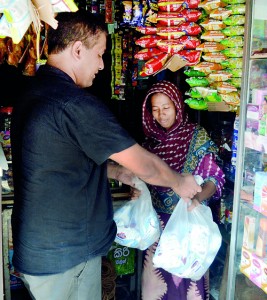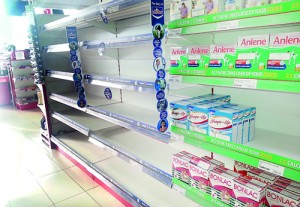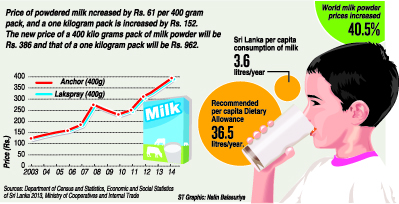News
Drinka pinta milka day? Those were the days
Noorul Bathirian, a mother of three, now has to make the tough decision of which of her family members she would give the precious

Liquid milk: The hottest commodity in town. Pix by Hasitha Kulasekera
glass of milk every morning. With her husband being paralysed and no steady income the slightest change in food prices has a thundering impact on the household diet.
Her children, three boys aged 14, 10 and 6 used to drink milk every day, and the family consumed a 400g packet of powdered milk each week. This has become a luxury following the price hike.
Last week, after months of speculation, the Consumer Affairs Authority approved a price rise for powdered milk. The 400g pack was increased by Rs. 61 and the 1kg pack by Rs.152, sending the prices to Rs.386 and Rs. 962 respectively.
Despite the high price, milk has become one of the most sought-after commodities due to its shortage in the market.
The shops are yet to receive full stocks after the price hike. For months, supermarkets and small grocery shops alike have sported empty milk powder shelves, some shops even apologising to their patrons about the non-availability of products.
“Now we only give my husband milk. My children don’t drink milk any more as we can’t afford it. They like it but it’s too expensive for us,” Ms. Bathirian said.

Kasun Gunawardana
For most Sri Lankans milk is seen as a valuable source of protein, calcium and vitamins.
Head of Department of Applied Nutrition in University of Wayamba, and council member of Nutrition Society, Dr. Anoma Chandrasekara, said that milk remains one of the main sources of proteins and other nutritions in Sri Lankan diet, especially for children, adolescents and pregnant and lactating mothers. While she did not specify a major difference between liquid and powdered milk, Dr. Chandrasekara said that if a person is to forgo consumption of milk, it should be replaced by other sources of protein.
As a result of the shortage of milk powder, liquid milk has become the hottest commodity in town. According to traders liquid milk moves fast and does not remain on shelves for long.
“Because there is a shortage people buy whatever they can get. There is also a noticeable switch from powder to liquid milk due to the DCD issue that came up last year,” Kasun Gunawardana, a grocery owner from Maligawatta area told the

Shops are yet to receive full stocks after the price hike of milk powder. Pic by Chathuri Dissanayake
Sunday Times.
The capacity of local producers to meet the demand is limited. According to data supplied by the Ministry of Livestock liquid milk consumption in Sri Lanka is currently less than 10 per cent because milk is not freely available in the local markets.
Local production barely meets even 50 per cent of the domestic demand: milk production in Sri Lanka last year was 352 million litres.
The Ministry of Livestock estimates the production should reach 785 million litres of milk in 2016 if the country is to be self-sufficient in milk. This translates to an increase of 300 per cent by next year according to the ministry’s strategic plan.
According to Minister Johnston Fernando the government’s aim is to make the country self- sufficient in liquid milk by 2020.
Minister Johnston Fernando responding to a series of questions raised in parliament on the issue said the move to increase milk powder prices was in order to promote liquid milk.
He said that it was the policy of government to protect and safeguard the interests of the indigenous dairy farmers and their industry.
“We did not permit the milk powder companies to increase the prices for 20 months. There is no problem in purchasing liquid milk today. Milk prices in the international market had undergone tremendous changes. The price of a tonne of a milk powder had been doubled,” he said.
It is learned that agents and suppliers of liquid milk brands are selective in which groceries they supply, due to the short life cycle and particular storage requirements of the products. Unless the suppliers are certain that the grocery owners do not switch off their refrigerators in the night or whether there is a strong market for the product, they will not supply the products to all groceries.
“In many small grocery shops the fridges are switched off at night to cut down on costs and this can spoil the product. It is the agent who gets into trouble if the product is spoilt. So we supply to only known groceries,” Sadun Perera, an agent for one of the leading liquid milk powder brands said.
Further, the short lifespan of liquid milk also regulates the selection process of the consumers. Often consumers who are unable to keep the milk refrigerated are prevented from buying the product and will have to go without milk in their daily diet. Some are in the habit of buying liquid milk each day to meet their daily requirement.
| Govt, milk firms, defend price move
The Ministry of Co-operatives and Internal Trade said the price rise requested by dairy companies was between Rs. 240 to Rs. 540 per kilo. “We want suppliers to survive as well. But we didn’t give approval to the price hike they asked. We annualised the world prices before giving approval to the current increase,” he said. He said the decision was in line with the government’s plan to be self-sufficient in milk by 2020. The ministry took this decision to protect local producers and farmers engaged in milk production, Mr. Ekanayake said. The market leader in imported powdered milk, Fonterra Brands Lanka, defended its application to increase prices. Managing Director Leon Clement claimed that prices of whole milk powder in the international market has gone up by around 40 per cent over the past 12 months and the trend was predicted to continue. He said production costs had also increased. “We have been absorbing the additional costs that resulted from these record high global milk powder prices which are unsustainable for any business,” he stated explaining the company’s decision to increase prices. Mr. Clement said the company could now increase the production in order to meet current demand. |

